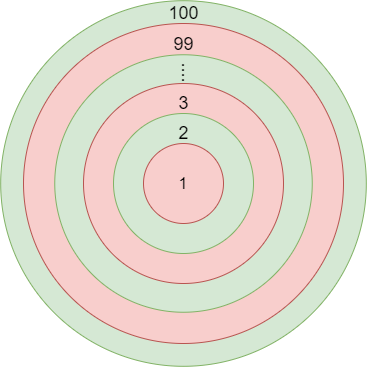
Concentric circles of radii 1, 2, 3, …, 100 cm are drawn. The interior of the smallest circle is coloured red and the angular regions are coloured alternatively green and red, so that no two adjacent regions are of the same colour. The total area of the green region in sq. cm is equal to
(a)
(b)
(c)
(d)
Answer
475.8k+ views
Hint: We solve this problem by using the formula of area of circle.
The formula of area of circle having the radius
We also have the formula of summation of squares of first
Complete answer:
Let us take a rough figure of the given circles as follows

Here, we can see that circles of odd radii are red colour and circles of even radii are green in colour.
We are asked to find the total area of the green region.
Let us assume that the area of first green region that is 2 as
We know that the formula of area of circle having the radius
By using the above formula we get the area of first green region as
Now, let us assume that the area of next green region as
By using the area of circle formula we get
Let us assume that the total area of the green region as
Now, let us divide the terms of even and odd terms separately then we get
Now, let us add and subtract the even terms in the above equation then we get
We know that the formula of summation of squares of first
By using this formula of sum of square of numbers in above equation then we get
Now, let us take the common terms out from both terms then we get
Therefore we can conclude that the area of green region is
So, option (b) is the correct answer.
Note:
Students may make mistakes in taking the area of the green region.
Here, we can see that the green region is not a complete circle which is the region.
The area of green region is obtained by difference of areas of two consecutive circles that is
But students may make mistakes when considering the figure.
They assume that the each region is a complete circle and take the equation as
This gives the wrong answer.
The formula of area of circle having the radius
We also have the formula of summation of squares of first
Complete answer:
Let us take a rough figure of the given circles as follows

Here, we can see that circles of odd radii are red colour and circles of even radii are green in colour.
We are asked to find the total area of the green region.
Let us assume that the area of first green region that is 2 as
We know that the formula of area of circle having the radius
By using the above formula we get the area of first green region as
Now, let us assume that the area of next green region as
By using the area of circle formula we get
Let us assume that the total area of the green region as
Now, let us divide the terms of even and odd terms separately then we get
Now, let us add and subtract the even terms in the above equation then we get
We know that the formula of summation of squares of first
By using this formula of sum of square of numbers in above equation then we get
Now, let us take the common terms out from both terms then we get
Therefore we can conclude that the area of green region is
So, option (b) is the correct answer.
Note:
Students may make mistakes in taking the area of the green region.
Here, we can see that the green region is not a complete circle which is the region.
The area of green region is obtained by difference of areas of two consecutive circles that is
But students may make mistakes when considering the figure.
They assume that the each region is a complete circle and take the equation as
This gives the wrong answer.
Latest Vedantu courses for you
Grade 10 | CBSE | SCHOOL | English
Vedantu 10 CBSE Pro Course - (2025-26)
School Full course for CBSE students
₹37,300 per year
Recently Updated Pages
Solve and find the value of x 25x40160 class 7 maths CBSE

The worship of images of Buddha in India began during class 7 social science CBSE

How do you find the simplified radical form of 54 class 7 maths CBSE

o no I am running late and may not make the plane to class 7 english CBSE

In the following sentence should Who or Whom be used class 7 english CBSE

Find all the integers between 4 and 4 class 7 maths CBSE

Trending doubts
Where did Netaji set up the INA headquarters A Yangon class 10 social studies CBSE

A boat goes 24 km upstream and 28 km downstream in class 10 maths CBSE

Why is there a time difference of about 5 hours between class 10 social science CBSE

The British separated Burma Myanmar from India in 1935 class 10 social science CBSE

The Equation xxx + 2 is Satisfied when x is Equal to Class 10 Maths

What are the public facilities provided by the government? Also explain each facility




